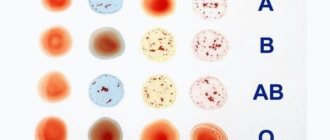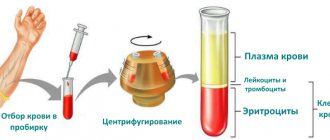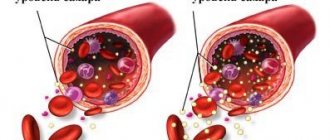Lupus anticoagulant is an indicator of the presence in the body of antibodies against its cell membrane phospholipids. When in the blood, the anticoagulant attaches to the vascular walls, causing platelets to join and stick together, which leads to the formation of blood clots. Blood clots form in the arterial and venous networks, causing acute circulatory disorders, as well as miscarriages during pregnancy.
Indications for blood tests:
- recurrent arterial or venous thrombosis;
- thromboembolism of the branches of the pulmonary artery;
- thrombocytopenia is hereditary or acquired;
- disturbance of cerebral (cerebral) blood flow - dyscirculatory encephalopathy, transient ischemic attack, ischemic stroke, especially when they develop at a young age;
- assessing the risk of blood loss before surgery.
When planning a pregnancy, the test will be offered to women if in the past they have:
- spontaneous abortions,
- frozen pregnancy,
- stillbirths,
- premature birth,
- severe late toxicosis,
- eclampsia,
- problems with conception.
The doctor will refer you for analysis if there is a vascular network on the skin, ulcerative defects, marbled coloration, or during treatment with anticoagulants.
A screening test is indicated in the first months of pregnancy at least twice with an interval of 6 weeks. In cardiorheumatology, analysis helps to determine the cause of rheumatic carditis and heart defects.
Contraindications include mental disorders, as well as a sharp decrease in blood pressure.
Preparing for diagnostics:
- drug withdrawal: Sinkumar – 2 weeks before; Warfarin – 10 days before; Heparin and similar products – five days before;
- three hours before the diagnosis, you should not engage in sports, physical labor, or be nervous;
- The test should only be taken on an empty stomach; in the morning you can drink tea without sugar.
Blood is taken from a vein and sodium citrate is added to it. The determination of the anticoagulant is carried out using the colorimetric method after mixing with snake venom.
Norm for women and men:
- Negative is the norm for a person. The threshold value is considered to be a level from 0.8 to 1.1 conventional units.
- Positive, in this case its activity will also be noted.
- Weakly positive - in the range from 1.2 to 1.5 conventional units.
- Increased – antibodies with moderate (up to two units) or high activity (from two units) were detected.
Reasons for deviations from the norm:
- complications of medication use;
- formation of antibodies to one’s own tissues – autoimmune disorders;
- systemic lupus erythematosus;
- multiple myeloma;
- ulcerative colitis;
- antiphospholipid syndrome;
- malignant neoplasms;
- rheumatoid arthritis.
During pregnancy, positive results may indicate a risk of miscarriage.
Read more in our article on lupus anticoagulant.
What is lupus anticoagulant in a blood test?
- Lupus anticoagulant are antibodies that interact with certain antigens of the human body. Such antibodies are usually called autoantibodies, and in such an interaction they begin to fight their own phospholipids and proteins associated with them - i.e. practically counteract their own immunity.
- Lupus anticoagulant belongs to immunoglobulins, most often belonging to class G. By triggering a reaction in the body against phospholipids, it begins to negatively affect blood clotting processes, disrupting them and leading to a significant slowdown in the formation of blood clots, preventing significant blood loss. It is believed that normally there is virtually no lupus anticoagulant.
- If such an anticoagulant is detected in a blood test, this indicates that with an increase in the time required for clotting, active formation of blood clots , and this can happen in absolutely any organs and parts of the body, which often causes heart attacks, pulmonary embolism, and miscarriages.
Blood clots form
Lupus anticoagulant: does it change throughout life?
- A healthy person should not have a lupus anticoagulant. And if the state of health does not undergo significant changes throughout life, then this indicator remains unchanged. But with a disease, for example, systemic lupus erythematosus, the amount of lupus anticoagulant increases in approximately 30-40% of patients.
- Doctors have noticed that the level of these antibodies begins to increase after a person has suffered an infectious disease, as autoimmune processes begin in the body. In addition, lupus anticoagulant levels sometimes increase in women preparing to become mothers. Also, the presence of lupus anticoagulant is characteristic of ongoing inflammatory processes, HIV infections, and certain types of oncology .
- Thus, since the above diseases are not congenital, but acquired, we can talk about changes in the level of lupus anticoagulant throughout life.
LUPUS ANTICOAGULANT. REASONS FOR INCREASING ITS LEVELS IN THE BLOOD, ANALYSIS AND ITS RESULTS.
The state of the blood coagulation system and its components, which transmit their activity throughout the body, allows us to establish a special set of tests called a coagulogram. One of its indicators is lupus anticoagulant. It was first isolated from the blood of patients suffering from systemic lupus erythematosus, hence its name. This coagulogram indicator belongs to the IgG class immunoglobulins - a group of antibodies produced to neutralize the effects of phospholipids.
Antiphospholipid syndrome
Lupus anticoagulant helps suppress the reaction in the blood from converting prothrombin to thrombin. These antibodies are formed in the body as a consequence of the formation of autoimmune processes after any infectious influences. More often this is one of the main signs of APS (antiphospholipid syndrome). An increase in the amount of anticoagulants in a person’s blood is perceived as a risk factor, indicating the body’s predisposition to venous and arterial thrombosis and the manifestation of an autoimmune process. Lupus anticoagulant affects hemostatic parameters, since phospholipids participate in their formation. The mechanism of its action is to neutralize phospholipids, which have a negative charge, as well as their complexes with proteins involved in blood clotting.
The main symptom of APS
Antiphospholipid syndrome can manifest itself in completely different ways, depending on the degree of vascular damage, the size of the blood clot, its location and the rate of blockage of the blood vessels.
The main symptom of APS is damage to the blood vessels of the skin, such as livedo reticularis. It is expressed by net-shaped bluish-purple spots, most often located on the skin of the extremities, sometimes on the chest. Their appearance is caused by stagnation of blood in venules, capillary surfaces, and microthrombosis. This pathology is also characterized by a feeling of pain, coldness, and changes in skin sensitivity. The disease may be complicated by swelling, and small areas of ulceration may also form in the affected areas.
Elevated anticoagulant levels
Increasing in quantity and affecting blood vessels, the lupus anticoagulant contributes to blockage of blood vessels, provoking pulmonary thromboembolism, myocardial infarction, and the development of autoimmune diseases. Its elevated level may be a sign of systemic lupus erythematosus, ischemic cerebrovascular accidents, and AIDS.
Reasons for the development of pathology
The causative factors for the appearance of lupus anticoagulant include autoimmune disorders such as rheumatoid arthritis, multiple myeloma, systemic lupus erythematosus, ulcerative colitis, and malignant tumors. These include secondary antiphospholipid syndrome and complications caused by drug therapy or taking certain medications.
Lupus anticoagulant test
Indications for the study are pathologies such as spider veins on the skin, venous and arterial thrombosis regardless of location, thromboembolism, persistent miscarriage, thrombocytopenia, false-positive Wasserman reaction, prolongation of APTT without good reason, livedo reticularis and others. The material for analysis is blood plasma. Its results are formulated in the form of such relative judgments as positive (significantly, moderately, weakly) or negative.
Lupus anticoagulant during pregnancy
An increase in the blood anticoagulant during pregnancy can cause the development of placental vascular thrombosis. This condition can lead to premature birth and intrauterine fetal death. If there is a threat of miscarriage, a test for lupus anticoagulant is performed twice with a break of 6 or 8 weeks. A positive result (in both cases), along with such manifestations as thrombosis of arteries, veins, retinal vessels, stroke, heart attack and others, confirms the presence of antiphospholipid syndrome in the woman.
But it is worth noting that the presence of a group of antibodies in the blood can be explained by a number of factors. It is impossible to make a diagnosis based solely on the presence of lupus anticoagulant in the blood. Its norm is maintained at 0.8-1.2 conventional units. Deviations should only serve as a reason for a more thorough medical examination.
Which doctor treats lupus anticoagulant?
- Gynecologists, immunologists, cardiologists and, of course, therapists observing the patient can prescribe testing according to their profile If the test was taken without a referral from a specialist, but as a general examination of the body, for example, during pregnancy, then first you need to contact your primary care physician. He will determine how dangerous (or not dangerous) the obtained indicators are and make recommendations.
- Direct treatment in the presence of a lupus anticoagulant is carried out by a rheumatologist specializing in pathologies caused by autoimmune diseases of connective tissues.
Contact a rheumatologist
Blood for lupus anticoagulant: preparation, on what day of the cycle to donate?
- In order to properly prepare for donating blood for a lupus anticoagulant and to eliminate errors in the result, it is necessary to eat food at least 8 hours before donating blood, so as not to provoke metabolic processes in the body, changes in the concentration of enzymes and substances. You can drink water, but no more than a glass.
- The day before the test, you should exclude fatty foods in order not to increase the fat components in the body. The same applies to alcohol intake - it should be excluded.
- Stop smoking at least an hour before the test, since the tar in tobacco smoke affects platelets. You must notify your doctor in advance if you are taking any medications, including dietary supplements - they can also affect the reliability of the result, and only the doctor will determine what you can continue to take and what needs to be stopped before donating blood.
- Blood for lupus anticoagulant must be donated in a calm, relaxed state, without engaging in sports or heavy physical work beforehand.
Need to prepare
- Women should donate blood on certain days of the menstrual cycle. This could be the fifth, seventh or tenth day - it depends on how long the cycle is. In general, the analysis is completed in the first third of the cycle. It is necessary to pay attention to spotting - if it is present, it is better to reschedule the analysis.
Lupus anticoagulant analysis transcript in seconds
The standard value (called the reference value) for screening is from 31 to 44 seconds, and for a confirmatory test, the result representing the norm is in the range from 30 to 38 seconds.
The index demonstrating the risk of lupus anticoagulant is determined in conventional units that correlate with this value and is:
- No risk – from 0.8 to 1.2
- The risk is weakly expressed – from 1.2 to 1.5
- Moderate indicator – from 1.5 to 2.0
- Strong risk – over 2
Decoding the results
A healthy person does not have VA in their blood, so the norm for this indicator in women and men is a negative result.
Laboratories use various methods for determining VA. Because of this, the values or units of measurement sometimes differ.
For example, the normal value is written as 31-44 seconds or 0.8 - 1.2. In order to correctly analyze the data, you need to know which method was used for the study.
Negative
In case of a negative result, it is simple to decipher the test conclusion - there is no lupus anticoagulant in the blood.
If the result is positive, the digital value of the indicator is recorded.
Positive
The table shows the breakdown of the positive analysis:
| Meaning | Interpretation |
| 1,2 – 1,5 | Weak positive result (low VA activity). |
| 1,5 — 2 | Positive – moderate activity. |
| 2 or more | High VA content carries a risk of thrombosis. |
A false positive result is obtained due to the use of anticoagulants. VA should be reduced at moderate and high values.
Lupus anticoagulant during pregnancy norm by week
As a rule, an analysis for the content of lupus anticoagulant is carried out when indicated, including during pregnancy. Usually, if there is a threat of miscarriage, the doctor prescribes a test for this anticoagulant twice, the interval between them is from 6 to 8 weeks.
If we talk about a detailed coagulogram, which studies blood clotting in general, then the norms during pregnancy are:
- From the 13th to the 21st week - 0.56 - 1.1
- From the 21st to the 29th week - 0.5 - 1.13
- From the 29th to the 35th week - 0.58 - 1.17
- From the 35th to 42nd week - 0.15 - 1.14
Depending on the week
Indications for determining VA
A test for lupus anticoagulant is not included in standard blood tests; a gynecologist, cardiologist, rheumatologist, or therapist recommends such a study, and the determination of VA is carried out if a pathology of hemostasis is suspected:
- To find out the causes of thrombosis;
- For miscarriages of unknown etiology;
- When the coagulogram changes (increased aPTT);
- When diagnosing antiphospholipid syndrome in combination with other tests;
- If anticardiolipin antibodies are detected;
- For infarctions of the brain, heart, transient ischemic attacks in young people (up to 45 years);
- For the diagnosis of autoimmune processes.
If antiphospholipid syndrome is suspected, a VA determination is always prescribed. With this disease, there may be no signs of thrombosis at all, but, nevertheless, the tendency to excessive coagulation is quite high. An increased anticoagulant in the blood of such patients is regarded as a risk of thrombosis and a manifestation of autoimmunization.
In autoimmune diseases accompanied by the formation of proteins that attack one’s own tissues, the appearance of VA is quite natural and reflects aggression against many cells, including platelets. Increasing the lupus anticoagulant in such patients requires timely prevention of thrombosis, which can lead to failure of various organs due to ischemia and necrosis.
If there are problems with pregnancy and pregnancy, a lupus anticoagulant indicates the presence of antiphospholipid syndrome. It is determined twice with an interval of one and a half to two months. If the value is present or elevated in both studies, antiphospholipid syndrome is likely. If a woman has signs of pathological thrombus formation (visual impairment, cerebral or cardiac infarction, thrombosis of the leg veins), an unfavorable obstetric history (miscarriages), then the diagnosis is beyond doubt.
Lupus anticoagulant: how many times should I take it?
There is a certain established algorithm that was developed by the International Society dealing with the problems of thrombosis and hemostasis.
It involves three stages of analysis for lupus anticoagulant:
- A screening assay looking at the extension of phospholipid-dependent coagulation studies is performed.
- A correction test aimed at finding out the reason for the violation of screening indicators.
- Final test , which establishes the nature of the inhibitor.
General information
Lupus anticoagulant (LA) - immunoglobulin G - combines a group of immune system antibodies that react to phospholipids and deactivate them. The latter are complex fats that are part of cell membranes. Neutralization of phospholipids and phospholipid-protein complexes is necessary to regulate blood clotting and slow down the process of thrombus formation.
An analysis for lupus coagulant is performed as part of a coagulogram and allows you to evaluate its other indicator - activated partial thromboplastin time (aPTT). The test results reflect the rate of blood clotting and also make it possible to predict the risks of bleeding or thrombosis.
Most often, a lupus anticoagulant is determined in patients with a prolonged aPTT and a tendency to thrombosis, which is characteristic of antiphospholipid syndrome (APS).
One of the most common symptoms of APS is “livedo reticularis,” when a capillary network appears on the skin, which becomes more noticeable at low temperatures. After vascular damage in APS, dysfunction of internal organs and associated diseases (Alzheimer's disease, cirrhosis, pulmonary embolism, myocardial infarction at an early age, etc.) may be observed. Also, antiphospholipid syndrome may be accompanied by ulceration and necrosis of certain areas of the skin. The intensity of APS manifestations depends on the size of the thrombus, its location, the degree of damage to the vessel and the rate of blockage of its lumen.
VA can also increase in pregnant women, which indicates the risk of miscarriage and premature birth.
Analysis for lupus anticoagulant makes it possible to timely identify this component in the blood and prevent the development of pathologies caused by thrombosis of veins and arteries.
Lupus anticoagulant: normal when planning pregnancy
- Testing for the presence of lupus anticoagulant when planning pregnancy is mandatory. In this case, a standard indicator not exceeding 1.2 is considered the norm. If the value is higher, then before deciding on motherhood, it is necessary to find out the reason for the increase in the level of lupus anticoagulant and eliminate it so as not to jeopardize either your own health or the intrauterine development of the baby.
- If you do not get rid of the disease that affects the value of the lupus anticoagulant, the risk of miscarriage or pathologies in the development of the embryo is extremely high - up to 95%. Therefore, it is necessary to test for these antibodies, and then periodically undergo repeated tests.
Be sure to consult your doctor
Lupus anticoagulant negative: what does it mean?
- A healthy person should not have blood components similar to the lupus coagulant, therefore, in the case when the analysis shows a result from 0 to 1.2, the result is said to be negative. This means that the lupus coagulant is either not detected in the blood at all, or its content is within the acceptable limit. In this case, doctors exclude the possibility of autoimmune pathology, as well as antiphospholipid syndrome.
- It is recommended to conduct a blood test in several stages so that repeated samples confirm the absence of lupus coagulant. It is the result that is determined by two tests that is considered negative.
Lupus anticoagulant weakly positive: what does it mean?
- When a woman is planning a pregnancy or is already in this pleasant state, she periodically undergoes various tests, among which there is always a blood test for the presence of lupus anticoagulant.
- There is a gradation of conventional units, according to which an indicator of up to 1.2 is the norm. If the analysis shows a result slightly higher (but not higher than 1.5) , doctors define this result as weakly positive.
- This indicator demonstrates the presence of a lupus anticoagulant in the blood, but at the same time its activity is quite low, which, however, does not negate the need to search for the reasons for the increase in the anticoagulant content and eliminate them.
Preparing for analysis
On the eve of the analysis, drinking water without gas is not prohibited
Blood for analysis is taken from any available vein. It is preferable to take blood in the morning on an empty stomach, after 8-10 hours of fasting at night. Before the study, you are allowed to drink still water. Other drinks (tea, coffee, soda, alcohol) should be excluded. If the analysis is required urgently, it is acceptable to fast for at least four hours before drawing blood.
Heavy mental and physical stress should also be excluded 1-2 days before the test, smoking - 30-60 minutes before the procedure.
The most important condition for a reliable blood test for VA is the temporary abolition of anticoagulants if the patient, for some reason, took them before the study. Only the attending physician can stop these medications, understanding all the risks that the patient may experience when stopping therapy. Heparin is usually discontinued 2 days before the test, warfarin - 10-14 days before it.
Lupus anticoagulant - weakly positive confirmatory test
- A coagulation test to detect lupus anticoagulant is a screening during which longer clotting times can be explained by a variety of reasons: from the actual presence of the lupus anticoagulant itself and its other “colleagues”, such as Heparin or Warfarin, to a deficiency of factors influencing clotting.
- To find out how much the lupus anticoagulant itself affects this process, it is necessary to conduct a confirmatory test when reagents are added in which phospholipids are in excess. If there is a normalization of the time during which blood clotting occurs, then it is the lupus anticoagulant that has an effect.
- If the time is not reduced, then other factors that may have an impact on it are checked one by one. to stop taking coumarin drugs and eliminate heparin some time before testing
Who is prescribed a blood test?
Determination of the anticoagulant is recommended for the following conditions:
- recurrent arterial or venous thrombosis;
- thromboembolism of the branches of the pulmonary artery;
- thrombocytopenia (low platelet count) hereditary or acquired;
- disturbance of cerebral (cerebral) blood flow - dyscirculatory encephalopathy, transient ischemic attack, ischemic stroke, especially when they develop at a young age;
- assessing the risk of blood loss before surgery.
For women, a lupus-type anticoagulant is prescribed in preparation for pregnancy if in the past there have been:
- spontaneous abortions,
- frozen pregnancy,
- stillbirths,
- premature birth,
- severe late toxicosis,
- eclampsia,
- problems with conception.
A blood test helps clarify the diagnosis when the activated thromboplastin time is prolonged (during which a blood clot forms), if the cause of this disorder has not been established and in case of a false positive reaction to syphilis. The doctor will refer you for analysis if there is a vascular network on the skin, ulcerative defects, marbled coloration, or during treatment with anticoagulants.
This technique is considered a reliable diagnostic method. Contraindications include mental disorders, as well as a sharp decrease in blood pressure. In such situations, the examination is carried out after complete normalization of the condition.
Watch the video about lupus erythematosus in children and pregnant women:
Lupus anticoagulant is elevated: reasons, why is it dangerous?
- An increase in the content of lupus anticoagulant may be due to diseases such as antiphospholipid syndrome, rheumatoid arthritis. An increase in this component is possible in systemic lupus erythematosus or multiple myeloma, as well as in nonspecific ulcerative colitis.
- A positive result cannot be ruled out in the presence of neoplasms. And finally, the reason for the increase in concentration may be the body’s reaction to certain medicinal substances that were used to treat a disease.
- For a pregnant woman, such a diagnosis can lead to infertility or miscarriage. It is possible that the pregnancy will falter or the birth of a non-viable child. There is also a threat to the life of the mother herself. In addition, an increase in lupus anticoagulant, which can provoke increased thrombus formation, can lead to strokes and heart attacks, affect the lower extremities, and manifest as thromboembolism.
Elevated indicators are dangerous
An increased level of lupus anticoagulant is especially dangerous for those who suffer from thrombosis or cardiovascular diseases, in cases of existing brain disorders or lack of platelets, in the presence of hemolytic anemia and antiphospholipid syndrome.
Risk factors for pregnant women
If a pregnant woman does not start treatment on time, the child dies in the womb.
Risk factors include women:
- suffering from thrombosis of veins and arteries;
- with antiphospholipid syndrome;
- with brain disorders;
- with cardiovascular diseases;
- have repeatedly suffered miscarriages, intrauterine fetal death, placental abruption, etc.;
- with an insufficient number of platelets in the blood;
- with bluish skin color;
- suffering from hemolytic anemia;
This group also includes women who:
- have a positive Wasserman reaction;
- underwent hormone replacement therapy;
- take oral contraceptives;
- have negative APS markers.
If the test for lupus anticoagulant is positive, it is repeated after three months to confirm or refute it.
How is lupus anticoagulant treated if it is elevated?
- The drugs prescribed by a doctor for the treatment of lupus anticoagulant depend on the amount of antibodies, history of thrombosis, etc. At the same time, if blood clots have not occurred before, then you may not have to resort to therapy.
- Basically, therapy involves anticoagulants such as Heparin, Warfarin or Aspirin, which slow down the process of production of vitamin K , which occurs in the liver, and, as a result, the time required for blood clotting. The duration of treatment is individual, from several months to constant use throughout life, and depends on the results of tests performed during treatment.
Drugs for treatment
- To reduce the level of antibodies, it is possible to prescribe steroids such as Prednisone, Cortisone, Methylprednisone. It may be necessary to undergo a plasma exchange procedure (or plasmapheresis), in which the affected plasma is replaced with high-quality plasma or its substitute.
- Among the “home” treatment methods, careful monitoring of other medications taken that can provoke the appearance of a lupus anticoagulant is necessary. After consulting your doctor, some of them may need to be discontinued.
- To improve blood circulation, it is vital to quit smoking, give up alcohol and lose excess weight, and to strengthen the cardiovascular system, engage in physical exercise.
Lupus anticoagulant in men
- Most often, lupus anticoagulant manifests itself in the form of antiphospholipid syndrome, and the most characteristic manifestation in men is thrombus formation, in particular venous. It may also manifest itself in the form of ischemic strokes and headaches.
A headache appears
- The heart may be affected, resulting in a risk of myocardial infarction, which is more common in men under 50 years of age. Lupus anticoagulant is also expressed in that the heart valves are affected and arterial hypertension develops. The skin, which is covered with a vascular network, is often affected; gangrene of the fingers is also possible.
- The liver may also become enlarged due to damaged vessels, liver enzymes may be more densely concentrated, and fluid may accumulate in the peritoneum, leading to ascites.
- Signs of the presence of lupus anticoagulant in men can be early thrombosis, including intestinal vessels, for which thrombosis is uncharacteristic. The risk is very high in men with a disease such as systemic lupus erythematosus. A low platelet count in the absence of blood-related diseases can also be an indicator.
Impact of VA on the body
During viral attacks, the human immune system produces special proteins that suppress the infection (immunoglobulin G). Their task is to detect the virus and protect the body from bacteria.
Autoimmune diseases disrupt this system. In the absence of an adequate protective reaction of the system, after the body is damaged by an infection, the process of deactivation of its own cells begins.
The body increases the level of lupus anticoagulant, which attacks phospholipids.
Antibodies prevent prothrombins, blood proteins, from being converted into thrombins. Because of this, blood clotting time increases. Antiphospholipid body syndrome develops. The main manifestations of this pathology are the formation of blood clots in deep veins and arteries.
Blood clots appear in different parts of the vascular system, causing blockage of the veins of the lower extremities, coronary arteries, and vessels leading to the brain.
As a result, the following diseases develop:
- pulmonary embolism;
- stroke;
- heart attack;
- ischemia;
- cerebral embolism.
Blood testing for VA is important in early detection of autoimmune diseases. This test is used to diagnose antiphospholipid syndrome.
Lupus anticoagulant and infertility
- Lupus anticoagulant and antiphospholipid syndrome are a common cause of female infertility.
Antibodies that counteract phospholipids, which is the lupus anticoagulant, are one of the reasons for the formation of blood clots in the blood vessels of the placenta. This, in turn, leads to malnutrition of the embryo, which can result in pregnancy failure, pathology of fetal development and intrauterine death, and abruption of the placenta itself.
- In the presence of a lupus anticoagulant, about 85% of pregnant women have complications during pregnancy, often ending in spontaneous abortion. Thus, what doctors call a habitual miscarriage is formed.
- Without treatment, almost 100% of pregnancies become problematic. Therefore, already at the planning stages of pregnancy, it is necessary to undergo a comprehensive examination of the body and be sure to be tested for the presence of lupus anticoagulant.
Its presence is very dangerous
How does lupus anticoagulant affect embryo implantation?
- With increased levels of lupus anticoagulant during pregnancy, bearing a fetus becomes difficult. Both spontaneous abortion and premature birth can occur, the fetus may have a delay in its development, even intrauterine embryonic death is possible.
- Due to the thrombotic effect of the lupus anticoagulant, thrombosis of the vessels contained in the placenta is possible, miscarriage of the embryo, and a delay in its growth. If the effect is non-thrombotic in nature, then the onset of pregnancy itself becomes difficult, since the implantation of the embryo is disrupted, which cannot consolidate and, accordingly, develop.
How to treat lupus anticoagulant during pregnancy?
- If a lupus coagulant is detected in the blood of a pregnant woman, the doctor, before prescribing treatment, studies the results of many tests and examinations that the expectant mother needs to undergo. Among them, the determination of antibodies in relation to cardiolipin, the coagulogram is necessarily monitored.
- Starting from the second trimester, the liver and kidneys are necessarily checked to determine indicators demonstrating how much creatinine , as well as cholesterol and urea, are contained in the body. In addition, monthly ultrasound examinations to monitor the process of fetal development, and Doppler measurements to determine the presence of risks. A pregnant woman should also consult a hematologist and geneticist.
Consultation with a specialized specialist is important
- Treatment is prescribed only based on the results of all examinations. The drugs that are commonly used to reduce antiphospholipid syndrome may be Heparin, Aspirin or Warfarin . To eliminate problems with autoimmune processes and to treat rheumatic pathologies, glucosteroids are prescribed. To reduce excess antibodies in the blood, the doctor may prescribe plasmapheresis . Typically, the course of treatment lasts three months, and regular blood tests are required to check for the presence of lupus anticoagulant.
Useful articles about health:
- The best drugs for migraines
- Back corset - what is it, how to use it
- Latest coronavirus
- Pre-illness state
- Prolapse and prolapse of the uterus
How to treat
If VA is detected in the blood, first of all you need to find the cause of its appearance. To do this, you should contact a therapist, who will either prescribe a diagnosis and further treatment, or refer you to another specialist. As a rule, this is a rheumatologist who deals with most pathologies associated with autoimmune connective tissue lesions.
In case of VA, therapy with corticosteroid drugs is indicated.
The main goals for diseases of this type are to reduce the activity of the immune system and relieve inflammation. For this purpose, glucocorticosteroids and, in some cases, cytostatics are prescribed. These medications must be taken according to a special regimen and strictly under the supervision of a doctor. Taking corticosteroids incorrectly can lead to serious complications.
Hydroxychloroquine is often prescribed to reduce the likelihood of thrombosis. The patient's condition can be improved using plasmapheresis.











